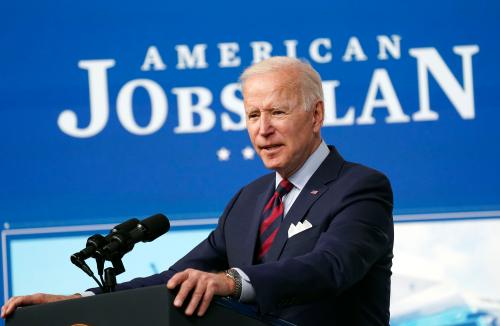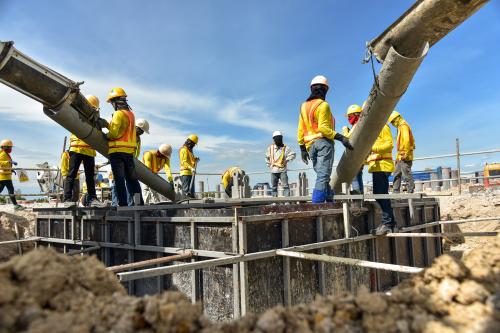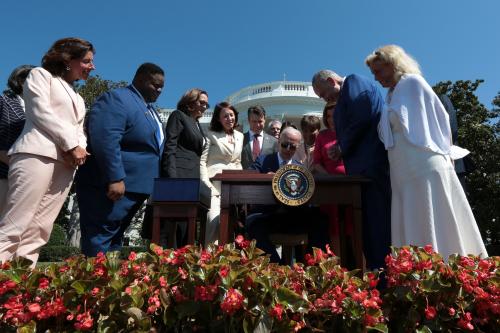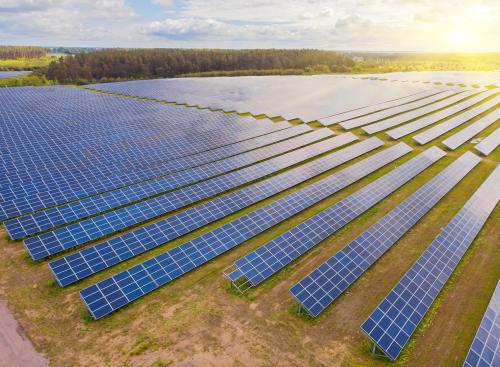This analysis is part of the American Rescue Plan: Strategies for Local Leaders series, a feature of the COVID-19 Metro Recovery Watch.
Contents
- The digital divide won’t go away on its own
- ARP authorizes sizable broadband investments
- ARP can address immediate broadband needs while laying the foundation for more durable digital equity
- Closing the digital divide begins now
For over two decades, digital equity advocates have done their best to raise awareness about the digital divide—the gap between those who can access and use internet-based services and those who cannot. All it took was a global pandemic and economic shutdown to finally get the public’s attention.
Stories from the past year made it impossible to ignore how essential broadband is in our daily lives: young students unable to login to their digital classroom; workers without in-home connectivity forced to travel to their job sites; retirees who couldn’t video chat with their families; and sick people who couldn’t access telehealth services.
Fortunately, the federal government is finally ready to address the digital divide. The Consolidated Appropriations Act of 2021 and the American Rescue Plan (ARP) Act offer billions of broadband-related dollars to reduce consumer prices, build out network infrastructure, and fund digital skills programming. And that funding may only be the start, as House and Senate leaders are coalescing around bipartisan legislation—similar to proposals within the American Jobs Plan—to construct broadband networks in every underserved neighborhood and dramatically expand support for digital equity services.
This federal activity is a welcome development, but it also creates a challenging puzzle for state and local leaders. The approved funding can improve digital equity right away, but it’s not enough to address every community’s long-term needs. Meanwhile, major broadband legislation (potentially rolled into a larger infrastructure package) promises to offer capital and operations funding at an appropriate scale, but it’s hard to count on money that’s not yet approved.
How should state and local leaders balance it all? We recommend a two-phase strategy.
The first phase should prioritize immediate relief. Leaders should leverage new resources to subsidize broadband subscriptions, lower device prices, and provide digital navigation and literacy support to ensure these affordability programs extend through the 2021-22 school year. Leaders should also prioritize only those network investments that can quickly initiate new service, such as E-rate connections through qualifying institutions like schools. Critically, state and local governments should use ARP funds (if permitted) or local resources to launch state and local digital equity offices to coordinate these programs, including benefits to both households and small businesses.
The second phase should predevelop a durable digital equity plan using ARP’s one-time funding infusion (and any additional local resources if necessary). New digital equity offices should aggressively measure digital need across their jurisdictions, including speed testing, accurate pricing data, physical network gaps, and locations for wraparound equity programming. Whichever agency manages broadband networks should then use the measurement data to develop a long-range capital plan to reach universal adoption, including pricing out capital investments with outside vendors and the specifications to launch cooperative-, civic-, or public-owned networks.
If executed well, this strategy can help state and local leaders reduce the digital divide today while designing a plan to permanently eliminate it in the coming decade.
The digital divide won’t go away on its own
It’s no longer a debate: Broadband is essential infrastructure. And no essential infrastructure should have the kinds of gaps we see within the broadband sector.
The best household data we can get is from the Census Bureau’s American Community Survey, which in 2019 found that roughly 16.7 million U.S. households (or 14%) did not have an in-home or wireless broadband subscription. But even that headline number understates the issue. Since wireline and wireless broadband are complementary goods, not substitutes, we really want every individual to have access to both. Unfortunately, there are another 24 million households (20%) that only have access to one or the other.

There are even more troubling broadband statistics among some of society’s most vulnerable. According to the Census Bureau’s Week 29 Household Pulse Survey—equivalent to April 28 through May 10, 2021—18% of households with children in public or private school did not always have internet available for educational purposes. Fifteen percent of white respondents and 16% of Asian American respondents reported not always having internet access for educational purposes, while 20% of Latino or Hispanic respondents and 21% of Black and mixed-race respondents faced this barrier. American Community Survey data also reveals a generational digital divide; 22% of those over age 65 have no broadband internet subscription, in comparison to 9% of those ages 18 to 64.
Researchers consistently find a set of factors that contribute to broadband gaps. Some communities, especially isolated towns, struggle with a lack of network connectivity. For some households and businesses, broadband subscriptions and devices are too expensive. And across entire communities, a lack of digital skills impedes adoption of digital services. Bridging the digital divide will require leaders at all levels of government, the private sector, and the civic community to design solutions that directly address these factors.
ARP authorizes sizable broadband investments
Congress has made an enormous amount of funding available to states and localities to address digital equity. ARP includes nine provisions that provide about $388.1 billion in flexible funding, for which a variety of digital equity activities are eligible (Figure 2). In addition, the Consolidated Appropriations Act created the $3.2 billion Emergency Broadband Benefit program, which the Federal Communications Commission (FCC) launched on May 12. While the magnitude of these investments is unprecedented, broadband is not guaranteed to emerge as the priority for all funding streams in all communities, so community leaders must break down these big numbers and plan how to get the most out of them.

Three programs—the Emergency Broadband Benefit, the ARP Emergency Connectivity Fund, and the ARP Capital Projects Fund—exclusively set aside funding for digital equity policies. These three programs together total $20.371 billion.
The Emergency Broadband Benefit (EBB) program is already providing broadband affordability relief to households; it provides a groundbreaking $50 per month ($75 in qualifying tribal lands) discount on broadband services, as well as a one-time $100 discount for purchasing eligible devices. State and local actors should shape their ARP efforts to complement this FCC-administered program, which will conclude when expended or six months after the COVID-19 emergency period ends, whichever occurs first.
To address the immediate educational impacts of the digital divide, ARP’s Emergency Connectivity Fund provides $7.171 billion in E-rate funding for emergency educational connections and devices for library patrons and school students. This level of funding puts schools and libraries on a viable path toward closing the homework gap by reimbursing 100% of reasonable costs paid to supply laptops, tablets, hotspots, and broadband subscriptions to students and their households. Notably, schools and libraries whose students and patrons have no commercially available connectivity options may even use the Emergency Connectivity Fund to support network construction and datacasting. The FCC’s May 11 final rule also clarified that any funds remaining after accepting all applications for future purchases could be used to reimburse past eligible purchases made during the COVID-19 pandemic.
An additional $10 billion is available through the ARP Capital Projects Fund to support “capital projects directly enabling work, education, and health monitoring, including remote options, in response to the public health emergency.” The Treasury Department indicated that broadband will be primary focus of the fund, as it seeks to meet the “continuing need for connectivity in response to the COVID-19 pandemic.” There are also opportunities for capital projects that provide other forms of connectivity access, such as community co-working hubs with digital assets. Further Treasury Department guidance on this fund is expected before applications are accepted this summer.
That leaves another $370.9 billion in an assortment of flexible ARP funds for which certain digital equity activities are eligible, but of which broadband will compete against other pressing relief and recovery needs. For schools and libraries, flexible funds include the $122.775 billion Elementary and Secondary School Emergency Relief Fund—for which a portion of funds are eligible to be spent on devices, software, and connectivity subscriptions for low-income students—and $200 million of flexible funding for the Institute of Museum and Library Services.
Beyond school students and library patrons, ARP’s $9.961 billion Homeowner Assistance Fund will provide timely relief to homeowners who experienced financial hardship after January 21, 2020 and who earn incomes below 150% of the area median income. The fund—which the Treasury Department allocates to states, territories, and tribes—covers a variety of expenses, including mortgage payment assistance, utility bills, and broadband internet service. While some of the larger eligible expenses dwarf the fund’s broadband expenses, the inclusion of broadband in the Homeowner Assistance Fund affirms ARP’s capacity to rapidly deliver essential broadband relief to households.
ARP’s Coronavirus State and Local Fiscal Recovery Funds offer the most flexibility for digital inclusion activities through $233 billion to state, local, territorial, and tribal governments. A wide range of digital inclusion activities, including physical network build-out in unserved and underserved areas, device and connectivity subscription support, and digital literacy training are eligible for these funds.
For newly constructed networks, Treasury Department guidance sets notable standards: They encourage recipients to provide symmetrical 100 megabits per second (Mbps) upload and download speeds (with exceptions), an attempt to match the rising demand for bandwidth we’ve seen in recent years. The guidance also encourages funding recipients to prioritize nonprofit, government-affiliated, and co-op internet service providers (ISPs). But this can be a challenge; in addition to the complexities of quickly standing up a new ISP, unserved and underserved areas could involve significant logistical challenges that slowed or halted commercial deployment in the first place. Funding recipients should take the time to plan and prepare beforehand if they decide to negotiate network construction contracts with large commercial ISPs; no community can afford for this wave of federal investment to build yet another expensive, inequitable, and sub-standard network. Finally, the guidance limits new network construction to unserved and underserved areas (those without “reliable” wireline service of at least 25 Mbps download and 3 Mbps upload speeds) although many places will need better data and mapping to understand where those areas actually are.
The Treasury Department’s guidance is much less restrictive for digital equity activities such as device and connectivity support and digital literacy training, all of which can be offered to any household that has suffered negative economic impacts due to COVID-19. Similarly, broadband subscription support is an eligible use of the fund’s loans and grants to mitigate small businesses’ financial hardship. However, since neighborhood-level broadband measurement is spotty at best, ARP recipients should justify new measurement and planning data as a prerequisite to targeting ARP programming dollars and maximizing return on investment.
ARP can address immediate broadband needs while laying the foundation for more durable digital equity
As helpful as ARP and other commitments are to bridging the digital divide, there simply is not enough funding to complete the job. It will take anywhere from $60 billion to over $100 billion to wire every American community for broadband, and that doesn’t include estimates to upgrade all wireline connections to fiber or to blanket the U.S. with 5G wireless. American communities also need funding for digital equity programs that lasts beyond 2024, including permanent federal offices to partner with. It’s going to take bigger, purpose-built broadband legislation—like that introduced by Sen. Amy Klobuchar (D-Minn.) and Rep. Jim Clyburn (D-S.C.), or wherever the White House’s infrastructure negotiation lands—to approach those funding amounts.
What today’s broadband dollars can do, though, is build a foundation for more durable digital equity while still targeting the most immediate needs of households and businesses who are digitally disconnected. To strike a balance between money available now and major legislation likely to pass during this Congress, we recommend state and local officials adopt a two-phase strategy.
Phase 1: Get emergency broadband support to those most in need
Even as regional economies begin to reopen, state and local leaders will still confront the same network, affordability, and skills issues that created the digital divide pre-pandemic. Those leaders should treat the digital divide like a long-run economic recession, getting emergency support to those most in need as quickly as possible. This should be the immediate focus while communities take a more patient approach to capital planning. During this phase, state and local leaders should:
- Immediately designate a chief digital equity officer and establish Digital Equity Offices as fast as possible. ARP and the EBB demand a broadband quarterback to coordinate programming across a jurisdiction. The programming breadth implicates multiple agencies and the potential for duplicative programming is enormous. If not already assigned, someone should serve as the chief coordinator of these equity-focused activities. States and localities should move quickly to establish a Digital Equity Office, which will house that officer plus other staff to permanently coordinate digital equity activities. They should explore whether ARP funding will cover the office’s operations, and also where to place the office, like inside state or local broadband offices that may already exist. In addition to network build-out and device and subscription support, Maryland’s planned $300 million dollar ARP broadband investments include $2 million each for digital navigator programs and the state’s digital inclusion fund, as well as $4 million for a new digital literacy program through the University System of Maryland.
- Tap programs to subsidize subscriptions. The digital equity officer should build relationships with multiple departments to make subscriptions more affordable, of which both the EBB and most ARP programs count as a qualified activity. Community health offices, libraries, schools, community groups, and community development financial institutions (CFDIs) should all encourage households to sign up for the EBB through local ISPs. The FCC prepared a ready-to-use EBB Outreach Toolkit to assist organizations in getting the word out. San Diego has already partnered with a local nonprofit and trusted community voice, Pillars of the Community, to help eligible residents take advantage of the benefit. School boards can establish programs this summer to promote connectivity for disconnected students. Housing and tax authorities can do the same for homeowners seeking discounted service. Economic development agencies can focus on monitoring small business needs. Across each of these instances, public officials should collect lists of who requested discounted service to inform ongoing measures of need, following the example set by California and Texas to compile location-specific lists to help households find available and affordable broadband plans.
- Get devices into people’s hands. Nearly all of the ARP programs plus the EBB allow device rebates for qualifying households. Digital equity officers should work with school boards, libraries, housing authorities, and other offices to get devices into people’s hands as quickly as possible. It is also worth exploring whether those devices should be wireless-capable and then bundled with discounted wireless service. Over the course of the pandemic, digital equity initiatives have helped community institutions across the country distribute devices, such as the St. Louis County Library’s use of CARES Act funds to distribute 1,500 wireless-capable “GrandPad” tablets to seniors in Missouri. Connected Nation’s State Connectivity COVID-19 Response Plan advises local actors to consider the varying device needs of different student and patron populations when purchasing or allocating donated devices.
- Top-up digital skills programming already underway. Many libraries and community nonprofits—such as Cleveland’s DigitalC and Ashbury Senior Computer Community Center—already offered digital skills curricula before COVID-19. The digital equity office should prioritize reinvestment in established skills programming to grow digital literacy and other skills.
Phase 2a: Invest in broadband measurement
Overcoming the digital divide won’t be easy, but it’s significantly harder without accurate data. Nearly all states and localities face a sweeping set of data gaps: incomplete maps of their network gaps; inaccurate readings on dependable internet speeds; an absence of pricing data; and outdated or inaccurate maps of household and business subscription rates. These data gaps compound when it comes to digital equity, since accurate data of broadband need would also help target digital skills services.
As an intermediate step, states and localities should immediately design and implement a long-term broadband measurement plan within their Digital Equity Office. Since the FCC is currently implementing the Broadband DATA Act—a 2020 federal law to enhance network availability data—state and local measures should focus on local data gaps, particularly pricing and more granular speed data. Local surveys of subscription rates among households and businesses are also important, and some of the data can be collected via the emergency relief programs detailed in Phase 1.
Improved measurement data has the opportunity to improve the effectiveness of capital programs and make them significantly cheaper to execute. With multiple years to execute capital programs and the opportunity to triage immediate gaps through other programming, state and local officials should not feel rushed when planning capital investments.
Phase 2b: Develop a capital plan and execute high-value projects with remaining funding
While the top-line figures are enormous, ARP may not leave nearly as much money available for capital investments as it initially seems. The need for immediate relief, such as hazard pay for workers, can quickly whittle down the total funding pot, especially from the oversized and flexible State and Local Fiscal Recovery Funds. Broadband also isn’t the only category of qualifying capital expenses, with water utilities and school systems as some of the other groups vying for limited dollars. In the end, broadband-focused officials will need to get creative.
We recommend state and local officials use this unique opportunity to develop a capital plan for long-term need. Similar to peers in the housing and transportation sectors, broadband officials can start to plan capital investments around their long-term needs. They should include planned stages of investment, using the broadband measurement plan to prioritize specific neighborhoods and projects. Capital plans are also an opportunity to conduct scenario planning, including new ownership models, federal legislative events, and new local revenue-raising models.
A capital plan will also help state and local officials determine which projects have the greatest potential to return value within the limits of remaining funding. ARP qualifies so many different projects and ownership models when it comes to broadband assets that governments need a clear way to judge different projects and build public trust on why officials select certain projects. A capital plan will help do that. Building off two pilot programs funded through the CARES Act, the Franklin County Digital Equity Coalition Framework in Ohio offers a leading example of the prerequisite measurement and engagement necessary to build an inclusive capital plan.
Closing the digital divide begins now
The COVID-19 pandemic has exposed the depths of the digital divide, finally convincing community leaders and the public that broadband is no longer a luxury. Fortunately, this collective awakening creates a major opportunity, which ARP’s broadband-related programs and the new EBB program help to fill.
These programs’ immediate relief is well timed for individuals and businesses who could benefit from lower prices and new digital skills. And with the promise of even bigger capital investments and operational funding through future broadband legislation, ARP programs also offer an opportunity to plan long-term investments. Community leaders should seize this opportunity to start overcoming the digital divide once and for all.









